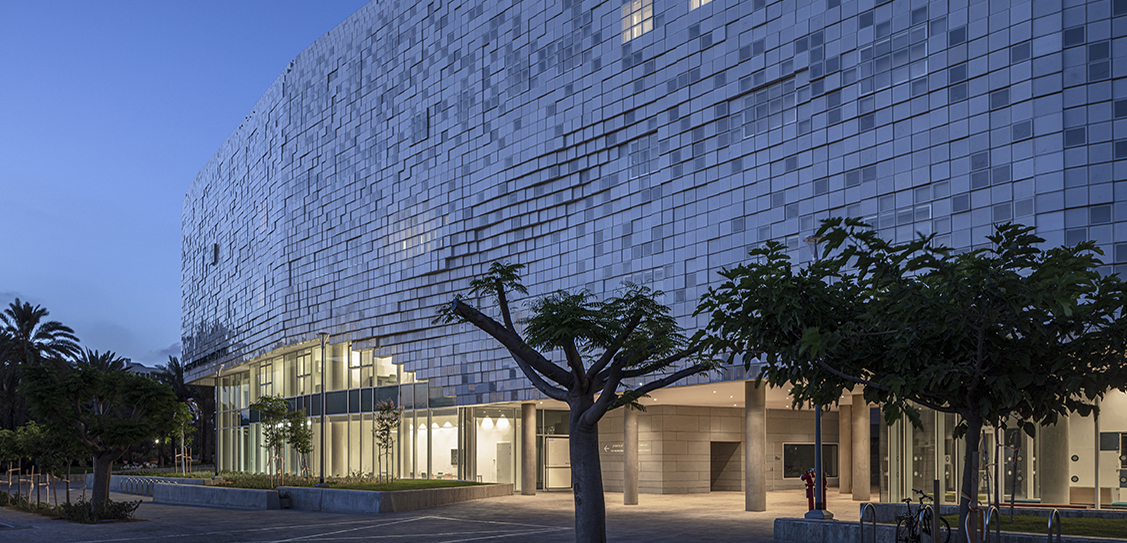Kimmel Eshkolot Architects unveils the Check Point Building for the Faculty of Computer Sciences and for science-oriented youth at Tel Aviv University. Located in the center of the campus, the technologically advanced building adapts to its surroundings with an integrated pixel-glass exterior. As a seemingly floating volume in the campus, it contrasts the adjacent Mario Botta designed iconic Cymbalista Synagogue and Jewish Heritage Center (1998) and the 1960s Faculty of Exact Sciences. The Check Point Building for the Faculty of Computer Sciences and for science-oriented youth joins a list of new university campus additions, including the Kimmel Eshkolot Architects' designed Steinhardt Museum of Natural History.
Donated by Check Point, an Israeli cybersecurity corporation, the new faculty building is a commitment to academic excellence and the training of a future generation of computer scientists and programmers. The building is designed to enable separation between its two groups of users (University students and youth program), yet encourages informal meetings between them, through the joint use of facilities, such as the auditorium and large classrooms.
The Check Point Building for the Faculty of Computer Sciences and for science-oriented youth is a new type of technology-integrated building with a unique envelope made of pixels of glass that were designed using parametric modeling. This shell was developed specifically for the project, and is an innovative system matching the values that the building represents. Its positioning frames an area to the west of the building, which supports its conversion from a parking lot to a central square in the campus.
The development of the unique technology implemented in the academic building had a critical influence on the design process by Kimmel Eshkolot Architects and the final result. The unique architectural language of the building strives to transcend the heavy materiality of buildings to the immaterial virtuality of computers and cloud computing. The building's exterior appears to be continually changing, from material to reflection, blending with the sky and clouds.
Technology often inspires architects and enables the realization of ideas which were not possible in the past. In the Check Point Building, as well as in our studio's work on the Memorial Hall of Israel's Fallen on Mount Herzl, technology no longer merely serves the architecture, but has become an essential part of the architectural idea.
Etan Kimmel of Kimmel Eshkolot Architects.The Check Point Building for the Faculty of Computer Sciences and for science-oriented youth's envelope is characterized by flowing and dynamic geometries, creating a connection between the wings: the Youth Wing and the Common Wing in the lower sections. Both wings converge towards the upper floors and meet at the Computer Science areas. Situated in the middle of the building is the garden patio and Youth Experiment Terrace. Sustainability was a major concern of the firm during the design process. The building courtyards are comprised of shaded and wind-ventilated which are appropriately oriented with respect to the sun and wind, and the double-skin facades permit ventilation and shading.
The building envelope consists of five types of 40 x 40 cm glass panels that are anchored to the building. The five configurations offer various levels of transparency and reflectivity, designed with parametric modeling with the needs of the users --transparency in the windows and garden areas and sealing in other parts. The more transparent panels can open in a parallel plane to the facade -- similar to the door of a bus -- therefore creating windows that visually maintain the overall volume, even when they are open. To blur the appearance of the windows in the collective mass during dark hours, a lighting system was designed to illuminate specific pixels and make the windows less visible.
Relating back to the aforementioned building’s double-skin facade, its glass pixels create a ventilated buffer zone and the spaces of the building 'breathe' the fresh air and the air-conditioning system inhales from this in-between area. The Check Point building's interior spaces and circulation system create informal meeting places and open the work areas in the common spaces and central atrium that integrate well with the defined staff rooms and laboratories.



